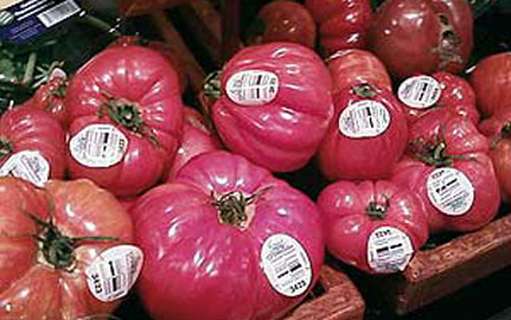GS1 DataBar on tomatoes
- Geschrieben von Joachim Heldt
 The retail company Metro wants to integrate the DataBar barcode into its overall concept of traceability. “From the latest generation of barcodes, we are expecting greater depth and transparency of data across the entire supply chain – from manufacturer to Point of Sale,” says Metro manager Jürgen Matern, explaining why they have opted for the GS1 DataBar.
The retail company Metro wants to integrate the DataBar barcode into its overall concept of traceability. “From the latest generation of barcodes, we are expecting greater depth and transparency of data across the entire supply chain – from manufacturer to Point of Sale,” says Metro manager Jürgen Matern, explaining why they have opted for the GS1 DataBar.
As part of a pilot project which Metro is running in conjunction with the Dutch trade association FrugiCom and GS1 Germany, it started by printing GS1 DataBars on the labels of tomatoes that were to be sold at its Metro Cash & Carry wholesale outlets throughout Germany. During subsequent checkout procedures, it was apparent that the codes were clearly readable and that integration into the POS systems was seamless, as was the transfer of data to the customer printout. As its next step, Metro plans to roll out the pilot scheme in all of its Cash & Carry wholesalers as well as its neighbourhood supermarkets in Germany.
In contrast to traditional EAN-13 barcodes which only encode Global Trade Item Numbers (GTINs), the GS1 DataBar compresses more information into less space. This means that the relevant data for tracing products can be encoded directly onto the price label, for example batch and serial numbers (SGTIN) in addition to the ‘best-before’ date. In the case of returns, the automatic identification of a product and its distribution route accelerates processes. And in the case of future product recalls, the customer will find it easier to tell whether he is affected by checking the GTIN and batch number on the receipt. It equally enables Metro to inform its customers directly about the latest recalls.
Matern has this to say: “The high quality of the data on the product benefits companies and consumers alike.”
In order to derive full advantage from efficiency savings along the entire supply chain, Metro is therefore considering the introduction of the GS1 DataBar in the medium term as a single, globally agreed standard which can be used in any country and on all foodstuffs.
